
Utopia Planitia is a large plain within Utopia, the largest recognized impact basin on Mars and in the Solar System with an estimated diameter of 3,300 km (2,100 mi). It is the Martian region where the Viking 2 lander touched down and began exploring on September 3, 1976, and the Zhurong rover touched down on May 14, 2021, as a part of the Tianwen-1 mission. It is located at the antipode of Argyre Planitia, centered at 46.7°N 117.5°E. It is also in the Casius quadrangle, Amenthes quadrangle, and the Cebrenia quadrangle of Mars.
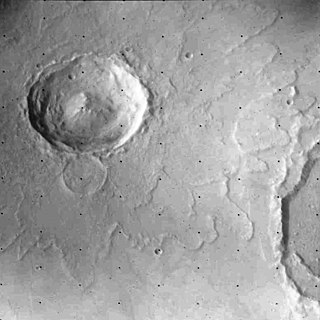
Rampart craters are a specific type of impact crater which are accompanied by distinctive fluidized ejecta features found mainly on Mars. Only one example is known on Earth, the Nördlinger Ries impact structure in Germany. A rampart crater displays an ejecta with a low ridge along its edge. Usually, rampart craters show a lobate outer margin, as if material moved along the surface, rather than flying up and down in a ballistic trajectory. The flows sometimes are diverted around small obstacles, instead of falling on them. The ejecta look as if they move as a mudflow. Some of the shapes of rampart craters can be duplicated by shooting projectiles into mud. Although rampart craters can be found all over Mars, the smaller ones are only found in the high latitudes where ice is predicted to be close to the surface. It seems that the impact has to be powerful enough to penetrate to the level of the subsurface ice. Since ice is thought to be close to the surface in latitudes far from the equator, it does not take a large impact to reach the ice level. Based on images from the Viking program in the 1970s, it is generally accepted that rampart craters are evidence of ice or liquid water beneath the surface of Mars. The impact melts or boils the water in the subsurface producing a distinctive pattern of material surrounding the crater.
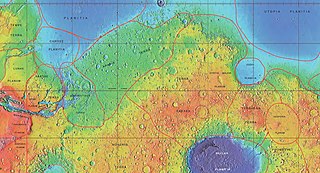
Terra Sabaea is a large area on Mars. Its coordinates are 2°N42°E and it covers 4,700 kilometres (2,900 mi) at its broadest extent. It was named in 1979 after a classic albedo feature on the planet. Terra Sabaea is fairly large and parts of it are found in five quadrangles: Arabia quadrangle, Syrtis Major quadrangle, Iapygia quadrangle, Ismenius Lacus quadrangle, and Sinus Sabaeus quadrangle.

The geology of Mars is the scientific study of the surface, crust, and interior of the planet Mars. It emphasizes the composition, structure, history, and physical processes that shape the planet. It is analogous to the field of terrestrial geology. In planetary science, the term geology is used in its broadest sense to mean the study of the solid parts of planets and moons. The term incorporates aspects of geophysics, geochemistry, mineralogy, geodesy, and cartography. A neologism, areology, from the Greek word Arēs (Mars), sometimes appears as a synonym for Mars's geology in the popular media and works of science fiction. The term areology is also used by the Areological Society.
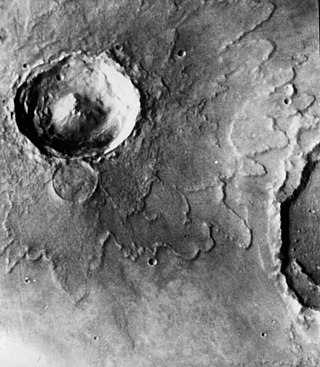
Yuty is a crater on Mars in Chryse Planitia, named after the town of Yuty in Paraguay. It measures approximately 19 kilometres in diameter, and is surrounded by complex ejecta lobes, which are a distinctive characteristic of martian impact craters.

The Ismenius Lacus quadrangle is one of a series of 30 quadrangle maps of Mars used by the United States Geological Survey (USGS) Astrogeology Research Program. The quadrangle is located in the northwestern portion of Mars' eastern hemisphere and covers 0° to 60° east longitude and 30° to 65° north latitude. The quadrangle uses a Lambert conformal conic projection at a nominal scale of 1:5,000,000 (1:5M). The Ismenius Lacus quadrangle is also referred to as MC-5. The southern and northern borders of the Ismenius Lacus quadrangle are approximately 3,065 km (1,905 mi) and 1,500 km (930 mi) wide, respectively. The north-to-south distance is about 2,050 km (1,270 mi). The quadrangle covers an approximate area of 4.9 million square km, or a little over 3% of Mars' surface area. The Ismenius Lacus quadrangle contains parts of Acidalia Planitia, Arabia Terra, Vastitas Borealis, and Terra Sabaea.

The Casius quadrangle is one of a series of 30 quadrangle maps of Mars used by the United States Geological Survey (USGS) Astrogeology Research Program. The quadrangle is located in the north-central portion of Mars’ eastern hemisphere and covers 60° to 120° east longitude and 30° to 65° north latitude. The quadrangle uses a Lambert conformal conic projection at a nominal scale of 1:5,000,000 (1:5M). The Casius quadrangle is also referred to as MC-6. Casius quadrangle contains part of Utopia Planitia and a small part of Terra Sabaea. The southern and northern borders of the Casius quadrangle are approximately 3,065 km and 1,500 km wide, respectively. The north to south distance is about 2,050 km. The quadrangle covers an approximate area of 4.9 million square km, or a little over 3% of Mars’ surface area.

The Cebrenia quadrangle is one of a series of 30 quadrangle maps of Mars used by the United States Geological Survey (USGS) Astrogeology Research Program. The quadrangle is located in the northeastern portion of Mars’ eastern hemisphere and covers 120° to 180° east longitude and 30° to 65° north latitude. The quadrangle uses a Lambert conformal conic projection at a nominal scale of 1:5,000,000 (1:5M). The Cebrenia quadrangle is also referred to as MC-7. It includes part of Utopia Planitia and Arcadia Planitia. The southern and northern borders of the Cebrenia quadrangle are approximately 3,065 km (1,905 mi) and 1,500 km (930 mi) wide, respectively. The north to south distance is about 2,050 km (1,270 mi). The quadrangle covers an approximate area of 4.9 million square km, or a little over 3% of Mars’ surface area.

The Arabia quadrangle is one of a series of 30 quadrangle maps of Mars used by the United States Geological Survey (USGS) Astrogeology Research Program. The Arabia quadrangle is also referred to as MC-12.

The Amazonis quadrangle is one of a series of 30 quadrangle maps of Mars used by the United States Geological Survey (USGS) Astrogeology Research Program. The Amazonis quadrangle is also referred to as MC-8.
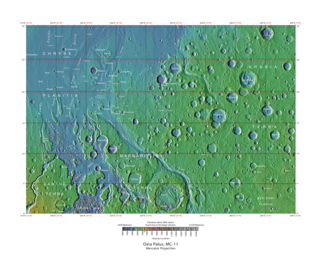
The Oxia Palus quadrangle is one of a series of 30 quadrangle maps of Mars used by the United States Geological Survey (USGS) Astrogeology Research Program. The Oxia Palus quadrangle is also referred to as MC-11.
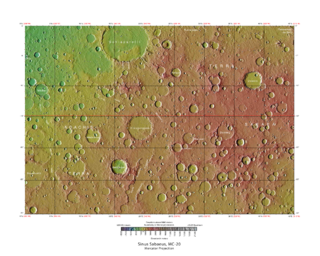
The Sinus Sabaeus quadrangle is one of a series of 30 quadrangle maps of Mars used by the United States Geological Survey (USGS) Astrogeology Research Program. It is also referred to as MC-20 . The Sinus Sabaeus quadrangle covers the area from 315° to 360° west longitude and 0° to 30° degrees south latitude on Mars. It contains Schiaparelli, a large, easily visible crater that sits close to the equator. The Sinus Sabaeus quadrangle contains parts of Noachis Terra and Terra Sabaea.

The Iapygia quadrangle is one of a series of 30 quadrangle maps of Mars used by the United States Geological Survey (USGS) Astrogeology Research Program. The Iapygia quadrangle is also referred to as MC-21. It was named after the heel of the boot of Italy. That name was given by the Greeks It is part of a region of Italy named Apulia. The name Iapygia was approved in 1958.

The Argyre quadrangle is one of a series of 30 quadrangle maps of Mars used by the United States Geological Survey (USGS) Astrogeology Research Program. The Argyre quadrangle is also referred to as MC-26. It contains Argyre Planitia and part of Noachis Terra.

The Mare Australe quadrangle is one of a series of 30 quadrangle maps of Mars used by the United States Geological Survey (USGS) Astrogeology Research Program. The Mare Australe quadrangle is also referred to as MC-30. The quadrangle covers all the area of Mars south of 65°, including the South polar ice cap, and its surrounding area. The quadrangle's name derives from an older name for a feature that is now called Planum Australe, a large plain surrounding the polar cap. The Mars polar lander crash landed in this region.
In planetary geology, a pedestal crater is a crater with its ejecta sitting above the surrounding terrain and thereby forming a raised platform. They form when an impact crater ejects material which forms an erosion-resistant layer, thus causing the immediate area to erode more slowly than the rest of the region. Some pedestals have been accurately measured to be hundreds of meters above the surrounding area. This means that hundreds of meters of material were eroded away. The result is that both the crater and its ejecta blanket stand above the surroundings. Pedestal craters were first observed during the Mariner missions.

Puńsk is an impact crater on Mars, located in the Oxia Palus quadrangle at 20.8° N and 41.2° W. It measures 11.6 kilometers in diameter and was named after the village of Puńsk in Poland.
The common surface features of Mars include dark slope streaks, dust devil tracks, sand dunes, Medusae Fossae Formation, fretted terrain, layers, gullies, glaciers, scalloped topography, chaos terrain, possible ancient rivers, pedestal craters, brain terrain, and ring mold craters.
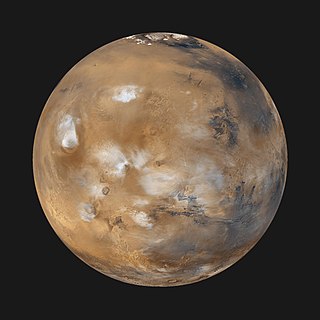
A low-aspect-ratio layered ejecta crater is a class of impact crater found on the planet Mars. This class of impact craters was discovered by Northern Arizona University scientist Professor Nadine Barlow and Dr. Joseph Boyce from the University of Hawaii in October 2013. Barlow described this class of craters as having a "thin-layered outer deposit" surpassing "the typical range of ejecta". "The combination helps vaporize the materials and create a base flow surge. The low aspect ratio refers to how thin the deposits are relative to the area they cover", Barlow said. The scientists used data from continuing reconnaissance of Mars using the old Mars Odyssey orbiter and the Mars Reconnaissance Orbiter. They discovered 139 LARLE craters ranging in diameter from 1.0 to 12.2 km, with 97% of the LARLE craters found poleward of 35N and 40S. The remaining 3% mainly traced in the equatorial Medusae Fossae Formation.

An expanded crater is a type of secondary impact crater. Large impacts often create swarms of small secondary craters from the debris that is blasted out as a consequence of the impact. Studies of a type of secondary craters, called expanded craters, have given insights into places where abundant ice may be present in the ground. Expanded craters have lost their rims, this may be because any rim that was once present has collapsed into the crater during expansion or, lost its ice, if composed of ice. Excess ice is widespread throughout the Martian mid-latitudes, especially in Arcadia Planitia. In this region, are many expanded secondary craters that probably form from impacts that destabilize a subsurface layer of excess ice, which subsequently sublimates. With sublimation the ice changes directly from a solid to gaseous form. In the impact, the excess ice is broken up, resulting in an increase in surface area. Ice will sublimate much more if there is more surface area. After the ice disappears into the atmosphere, dry soil material will collapse and cause the crater diameter to become larger.



























